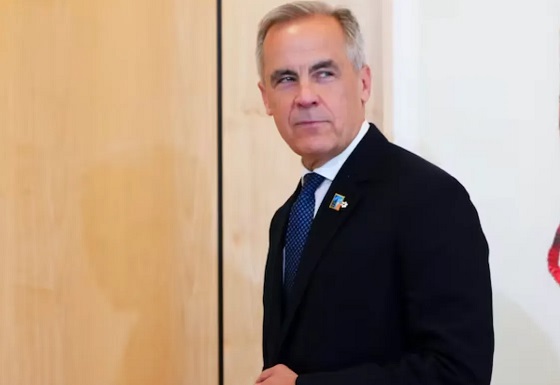Fraser Institute
Carney government’s housing plan poses major risks to taxpayers

From the Fraser Institute
By Jake Fuss and Austin Thompson
A trade war, Trump’s threats to Canada’s sovereignty, and global economic volatility loomed large in the recent federal election. Yet many voters remained focused on an issue much closer to home: housing affordability.
In 2023, under Justin Trudeau, Canada added a record high 1.2 million new residents—more than double the previous record in 2019—and another 951,000 new residents last year. All told, Canada’s population has grown by about 3 million people since 2022—roughly matching the total population increase during the entire decade of the 1990s. Not surprisingly, homebuilding has failed to keep pace. In fact, housing construction rates have barely exceeded 1970s levels, even though the population has more than tripled since then. The result—a historic surge in housing costs.
On the campaign trail, the Liberals set an immigration target of about 400,000 per year, which is lower than the recent record highs but still high by historical standards, and tabled a plan they claim will double Canada’s residential construction rate to 500,000 new homes per year within a decade. But is it a good plan? And can the Liberals deliver it?
First, the good news. To help boost private homebuilding, the Carney government promised to introduce tax incentives including a rental building allowance, which would help reduce the tax bill on new multi-unit rental buildings, and a GST exemption for some first-time homebuyers, which may reduce the cost of newly-built homes and spur more homebuilding. The government also plans to expand the “Housing Accelerator Fund,” which offers federal dollars to municipalities in exchange for more flexible municipal building rules, and modernize the federal building code, which could shorten construction timelines. While much will depend on execution, these policies rightly aim to make it faster, cheaper and more attractive for the private sector to build homes.
Now, the bad news. The Carney government plans to create a new federal entity called Build Canada Homes (BCH) to “get the government back in the business of building.” According to Carney’s vision, the BCH will act “as a developer to build affordable housing” and provide more than “$25 billion in financing” to homebuilders and “$10 billion in low-cost financing and capital” for homebuilders to build “affordable” homes.
We’ve seen a similar movie before. In 2017, the Trudeau government created the Canada Infrastructure Bank (CIB) to invest in the “next generation of infrastructure Canadians need.” Since then, the CIB has approved approximately $13.2 billion in investments across 76 projects (as of July 2024), yet only two CIB-funded projects had been completed, prompting the authors of a multi-party House of Commons committee report to recommend abolishing the CIB.
The bureaucrats who will run the BCH won’t have the private sector’s expertise in housing development, nor the same incentives to keep costs down. BCH’s mandate is already muddled by competing goals—it must deliver “affordable” homes while simultaneously prioritizing certain building materials (e.g. Canadian softwood lumber), which could increase building costs.
The plan for BCH’s multi-billion-dollar loan portfolio includes significant “low cost” (that is, taxpayer subsidized) financing, a huge bet on prefabricated homebuilding, and no certainty about who will be on the hook for any failed projects—combined, this represents a major increase in costs and risks for taxpayers at a time when they already shoulder rising federal deficits and debt.
There’s also a real risk that BCH will simply divert limited investment dollars and construction resources away from private homebuilding—where projects respond to the needs of Canadian homebuyers and renters—and toward government-backed housing projects shaped by political goals. Instead of boosting overall homebuilding, BCH may simply reshuffle limited resources. And, as noted by the government, there’s a severe shortage of skilled construction labour in Canada.
It’s hard to see how Carney’s housing plan would double the pace of homebuilding in Canada—a very ambitious target that would require not only prudent housing policies but greater domestic savings, an implausibly large expansion in the construction workforce (which grew by only 18.4 per cent over the last decade), and the political fortitude to endure vocal opposition to housing development in certain neighbourhoods and on public lands.
Canada’s housing crisis will benefit from federal leadership—but not federal overreach. Rather than overpromising what it can’t deliver, the Carney government should refocus on what it’s best positioned to do: reform incentives, streamline regulations, and nudge municipalities and provinces to remove constraints on homebuilding. Trying to also act as a housing developer and lender is a far riskier approach.
Banks
Scrapping net-zero commitments step in right direction for Canadian Pension Plan

From the Fraser Institute
By Matthew Lau
And in January, all of Canada’s six largest banks quit the Net-Zero Banking Alliance, an alliance formerly led by Mark Carney (before he resigned to run for leadership of the Liberal Party) that aimed to align banking activities with net-zero emissions by 2050.
The Canada Pension Plan Investment Board (CPPIB) has cancelled its commitment, established just three years ago, to transition to net-zero emissions by 2050. According to the CPPIB, “Forcing alignment with rigid milestones could lead to investment decisions that are misaligned with our investment strategy.”
This latest development is good news. The CPPIB, which invest the funds Canadians contribute to the Canada Pension Plan (CPP), has a fiduciary duty to Canadians who are forced to pay into the CPP and who rely on it for retirement income. The CPPIB’s objective should not be climate activism or other environmental or social concerns, but risk-adjusted financial returns. And as noted in a broad literature review by Steven Globerman, senior fellow at the Fraser Institute, there’s a lack of consistent evidence that pursuing ESG (environmental, social and governance) objectives helps improve financial returns.
Indeed, as economist John Cochrane pointed out, it’s logically impossible for ESG investing to achieve social or environmental goals while also improving financial returns. That’s because investors push for these goals by supplying firms aligned with these goals with cheaper capital. But cheaper capital for the firm is equivalent to lower returns for the investor. Therefore, “if you don’t lose money on ESG investing, ESG investing doesn’t work,” Cochrane explained. “Take your pick.”
The CPPIB is not alone among financial institutions abandoning environmental objectives in recent months. In April, Canada’s largest company by market capitalization, RBC, announced it will cancel its sustainable finance targets and reduce its environmental disclosures due to new federal rules around how companies make claims about their environmental performance.
And in January, all of Canada’s six largest banks quit the Net-Zero Banking Alliance, an alliance formerly led by Mark Carney (before he resigned to run for leadership of the Liberal Party) that aimed to align banking activities with net-zero emissions by 2050. Shortly before Canada’s six largest banks quit the initiative, the six largest U.S. banks did the same.
There’s a second potential benefit to the CPPIB cancelling its net-zero commitment. Now, perhaps with the net-zero objective out of the way, the CPPIB can rein in some of the administrative and management expenses associated with pursuing net-zero.
As Andrew Coyne noted in a recent commentary, the CPPIB has become bloated in the past two decades. Before 2006, the CPP invested passively, which meant it invested Canadians’ money in a way that tracked market indexes. But since switching to active investing, which includes picking stocks and other strategies, the CPPIB ballooned from 150 employees and total costs of $118 million to more than 2,100 employees and total expenses (before taxes and financing) of more than $6 billion.
This administrative ballooning took place well before the rise of environmentally-themed investing or the CPPIB’s announcement of net-zero targets, but the net-zero targets didn’t help. And as Coyne noted, the CPPIB’s active investment strategy in general has not improved financial returns either.
On the contrary, since switching to active investing the CPPIB has underperformed the index to a cumulative tune of about $70 billion, or nearly one-tenth of its current fund size. “The fund’s managers,” Coyne concluded, “have spent nearly two decades and a total of $53-billion trying to beat the market, only to produce a fund that is nearly 10-per-cent smaller than it would be had they just heaved darts at the listings.”
Scrapping net-zero commitments won’t turn that awful track record around overnight. But it’s finally a step in the right direction.
Business
Federal fiscal anchor gives appearance of prudence, fails to back it up

From the Fraser Institute
By Jake Fuss and Grady Munro
The Parliamentary Budget Officer (PBO)—which acts as the federal fiscal watchdog—released a new report highlighting concerns with the Carney government’s fiscal plan. Key among these concerns is the fact that the government’s promise to balance its “operating budget” does not actually ensure the nation’s finances are sustainable. Instead, the plan to balance the operating budget by 2028/29 gives the appearance of fiscal prudence, but allows the government to continue running large deficits and borrow more money.
First, what’s the new government’s fiscal plan?
While the Carney government has chosen to delay releasing a budget until the fall—leaving Canadians and parliamentarians in the dark about the state of government finances and where we’re headed—the Liberal platform and throne speech lay out the plan in broad strokes.
The Carney government plans to introduce a new framework that splits federal spending into two separate budgets: The operating budget and the capital budget. The operating budget will include “day-to-day” spending (e.g. government salaries, cash transfers to provinces and individuals, etc.) while the capital budget will include spending on “anything that builds an asset.” Within this framework, the government has set itself an objective—also called a ‘fiscal anchor’—to balance the operating budget over the next three years.
Fiscal anchors help guide policy on government spending, taxes and borrowing, and are intended to prevent government finances from deteriorating while ensuring that debt is sustainable for future generations. The previous federal government made a habit of violating its own fiscal anchors—to the detriment of national finances—but the Carney government has promised a “very different approach” to fiscal policy.
The PBO’s new report highlights two critical concerns with this new approach to finances. First, the federal government has not yet defined what “operating” spending is and what “capital” spending is. Therefore, it’s difficult to know whether any new spending policies—such as the recently announced increase in defence spending—will hurt efforts to achieve the government’s goal of balancing the operating budget and how much overall debt will be accumulated. In other words, the government’s plan to split the budget in two simply muddies the waters and makes it harder to evaluate federal finances.
The PBO’s second, and more alarming, concern is that even if the government achieves its goal to balance the operating budget, federal finances may still continue to deteriorate and debt may rise at an unsustainable rate (growing faster than the economy).
While the Liberal election platform does outline a fiscal path that appears to balance the operating budget by 2028/29, this path also includes higher deficits and more borrowing than the previous government’s plan once you factor in capital spending. Specifically, the Carney government plans to run overall deficits over the next four years that are a combined $93.4 billion more than was previously planned in last year’s fall economic statement. This means that rather than the “very different approach” that Canadians have been promised, the Carney government may continue (or even worsen) the same costly habits of endless borrowing and rising debt.
The PBO is right to call out the major transparency issues with the Carney government’s new budget framework and fiscal anchor. While the devil will be in the details of the government’s fiscal plan, and we won’t know those details until it releases a budget, the government’s new fiscal anchor gives the appearance of prudence without the substance to back it up.
-

 Bruce Dowbiggin3 hours ago
Bruce Dowbiggin3 hours agoWhat Connor Should Say To Oilers: It’s Not You. It’s Me.
-

 Business4 hours ago
Business4 hours agoFederal fiscal anchor gives appearance of prudence, fails to back it up
-

 Business2 hours ago
Business2 hours agoThe Passage of Bill C-5 Leaves the Conventional Energy Sector With as Many Questions as Answers
-

 Alberta29 mins ago
Alberta29 mins agoAlberta poll shows strong resistance to pornographic material in school libraries
-

 Banks1 hour ago
Banks1 hour agoScrapping net-zero commitments step in right direction for Canadian Pension Plan
-

 Business2 days ago
Business2 days agoOttawa Funded the China Ferry Deal—Then Pretended to Oppose It
-

 Alberta2 days ago
Alberta2 days agoAlberta’s government is investing $5 million to help launch the world’s first direct air capture centre at Innisfail
-

 armed forces2 days ago
armed forces2 days agoMark Carney Thinks He’s Cinderella At The Ball






